Page 381 of 544
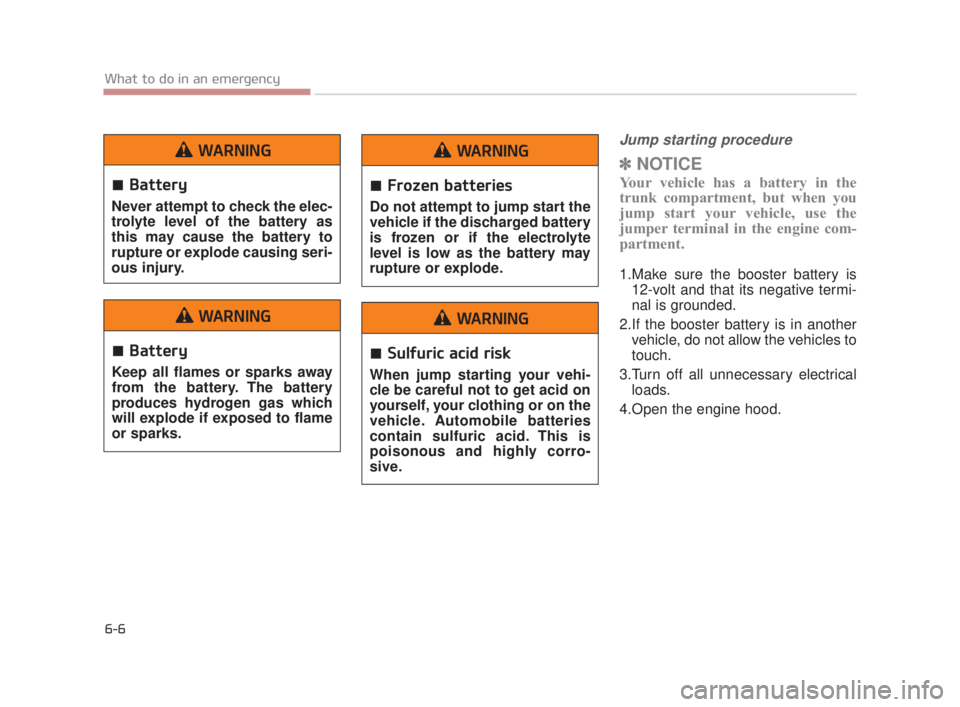
6-6
What to do in an emergency
Jump starting procedure
✽NOTICE
Your vehicle has a battery in the
trunk compartment, but when you
jump start your vehicle, use the
jumper terminal in the engine com-
partment.
1.Make sure the booster battery is
12-volt and that its negative termi-
nal is grounded.
2.If the booster battery is in another vehicle, do not allow the vehicles to
touch.
3.Turn off all unnecessary electrical loads.
4.Open the engine hood.
Battery
Never attempt to check the elec-
trolyte level of the battery as
this may cause the battery to
rupture or explode causing seri-
ous injury.
WARNING
Battery
Keep all flames or sparks away
from the battery. The battery
produces hydrogen gas which
will explode if exposed to flame
or sparks.
WARNING
Frozen batteries
Do not attempt to jump start the
vehicle if the discharged battery
is frozen or if the electrolyte
level is low as the battery may
rupture or explode.
WARNING
Sulfuric acid risk
When jump starting your vehi-
cle be careful not to get acid on
yourself, your clothing or on the
vehicle. Automobile batteries
contain sulfuric acid. This is
poisonous and highly corro-
sive.
WARNING
KH USA 6:2018 4/12/2017 10:21 AM Page 6
Page 382 of 544
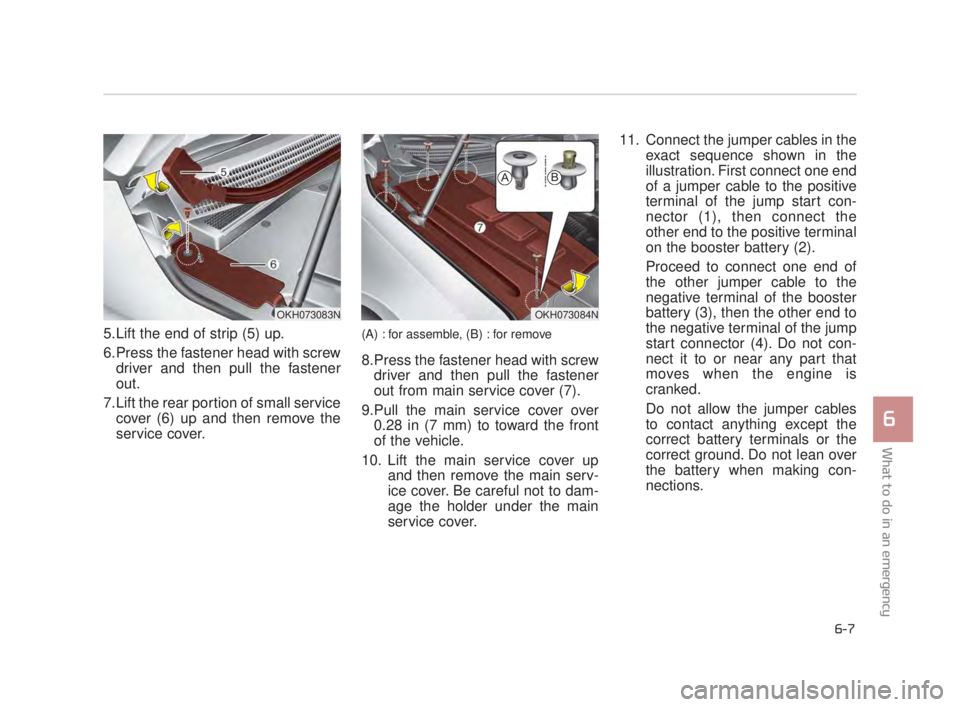
5.Lift the end of strip (5) up.
6.Press the fastener head with screwdriver and then pull the fastener
out.
7.Lift the rear portion of small service cover (6) up and then remove the
service cover.(A) : for assemble, (B) : for remove
8.Press the fastener head with screwdriver and then pull the fastener
out from main service cover (7).
9.Pull the main service cover over 0.28 in (7 mm) to toward the front
of the vehicle.
10. Lift the main service cover up and then remove the main serv-
ice cover. Be careful not to dam-
age the holder under the main
service cover. 11. Connect the jumper cables in the
exact sequence shown in the
illustration. First connect one end
of a jumper cable to the positive
terminal of the jump start con-
nector (1), then connect the
other end to the positive terminal
on the booster battery (2).
Proceed to connect one end of
the other jumper cable to the
negative terminal of the booster
battery (3), then the other end to
the negative terminal of the jump
start connector (4). Do not con-
nect it to or near any part that
moves when the engine is
cranked.
Do not allow the jumper cables
to contact anything except the
correct battery terminals or the
correct ground. Do not lean over
the battery when making con-
nections.
What to do in an emergency
6
6-7
OKH073083NOKH073084N
AB
KH USA 6:2018 4/12/2017 10:21 AM Page 7
Page 383 of 544
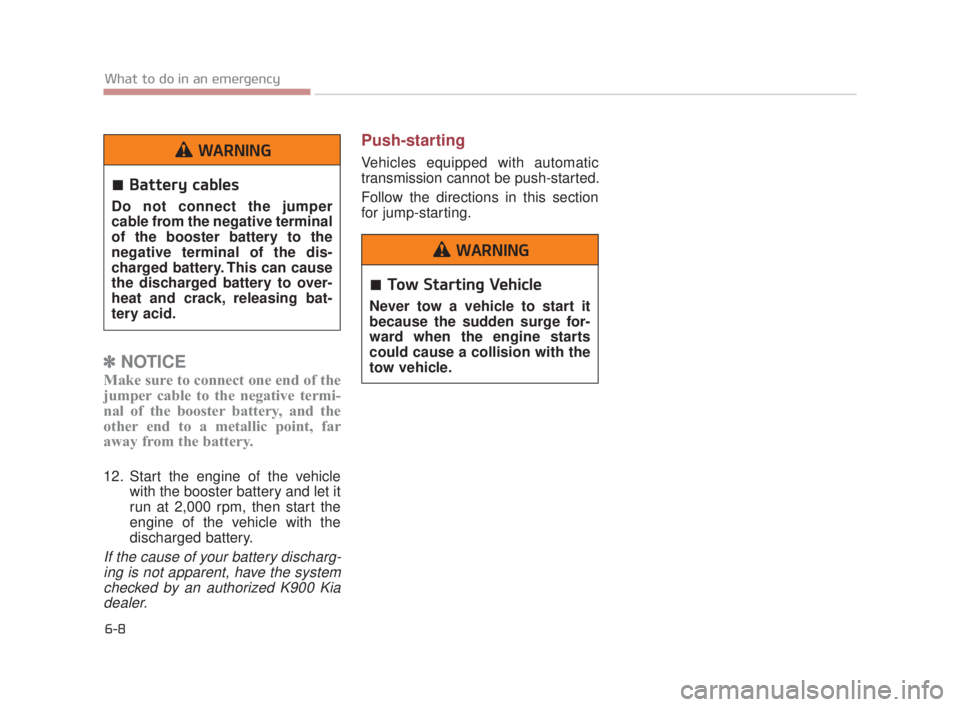
6-8
What to do in an emergency
✽NOTICE
Make sure to connect one end of the
jumper cable to the negative termi-
nal of the booster battery, and the
other end to a metallic point, far
away from the battery.
12. Start the engine of the vehicle
with the booster battery and let it
run at 2,000 rpm, then start the
engine of the vehicle with the
discharged battery.
If the cause of your battery discharg-ing is not apparent, have the systemchecked by an authorized K900 Kiadealer.
Push-starting
Vehicles equipped with automatic
transmission cannot be push-started.
Follow the directions in this section
for jump-starting.
Tow Starting Vehicle
Never tow a vehicle to start it
because the sudden surge for-
ward when the engine starts
could cause a collision with the
tow vehicle.
WARNING
Battery cables
Do not connect the jumper
cable from the negative terminal
of the booster battery to the
negative terminal of the dis-
charged battery. This can cause
the discharged battery to over-
heat and crack, releasing bat-
tery acid.
WARNING
KH USA 6:2018 4/12/2017 10:21 AM Page 8
Page 384 of 544
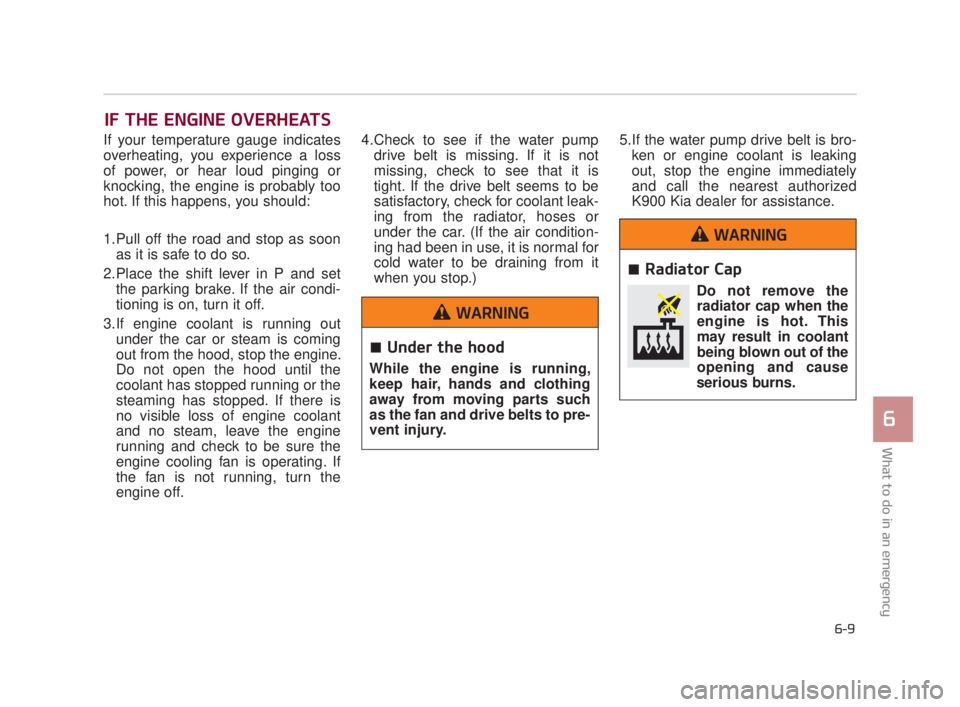
IF THE ENGINE OVERHEATS
If your temperature gauge indicates
overheating, you experience a loss
of power, or hear loud pinging or
knocking, the engine is probably too
hot. If this happens, you should:
1.Pull off the road and stop as soonas it is safe to do so.
2.Place the shift lever in P and set the parking brake. If the air condi-
tioning is on, turn it off.
3.If engine coolant is running out under the car or steam is coming
out from the hood, stop the engine.
Do not open the hood until the
coolant has stopped running or the
steaming has stopped. If there is
no visible loss of engine coolant
and no steam, leave the engine
running and check to be sure the
engine cooling fan is operating. If
the fan is not running, turn the
engine off. 4.Check to see if the water pump
drive belt is missing. If it is not
missing, check to see that it is
tight. If the drive belt seems to be
satisfactory, check for coolant leak-
ing from the radiator, hoses or
under the car. (If the air condition-
ing had been in use, it is normal for
cold water to be draining from it
when you stop.) 5.If the water pump drive belt is bro-
ken or engine coolant is leaking
out, stop the engine immediately
and call the nearest authorized
K900 Kia dealer for assistance.
What to do in an emergency
6
6-9
Under the hood
While the engine is running,
keep hair, hands and clothing
away from moving parts such
as the fan and drive belts to pre-
vent injury.
WARNING
Radiator Cap
Do not remove theradiator cap when the
engine is hot. This
may result in coolant
being blown out of the
opening and cause
serious burns.
WARNING
KH USA 6:2018 4/12/2017 10:21 AM Page 9
Page 385 of 544
6-10
What to do in an emergency
6.If you cannot find the cause of theoverheating, wait until the engine
temperature has returned to nor-
mal. Then, if coolant has been lost,
carefully add coolant to the reser-
voir to bring the fluid level in the
reservoir up to the halfway mark.
7.Proceed with caution, keeping alert for further signs of overheat-
ing. If overheating happens again,
call an authorized K900 Kia dealer
for assistance.
Serious loss of coolant indicates there is a leak in the cooling sys-
tem and this should be checked as
soon as possible by an authorized
K900 Kia dealer.
When the engine overheats
from low engine coolant, sud-
denly adding engine coolant
may cause cracks in the engine.
To prevent damage, add engine
coolant slowly in small quanti-
ties.
CAUTION
KH USA 6:2018 4/12/2017 10:21 AM Page 10
Page 387 of 544

Please note that the TPMS is not a
substitute for proper tire maintenance,
and it is the driver’s responsibility to
maintain correct tire pressure, even if
under-inflation has not reached the
level to trigger illumination of the
TPMS low tire pressure telltale.Your vehicle has also been equipped
with a TPMS malfunction indicator to
indicate when the system is not oper-
ating properly. The TPMS malfunction
indicator is combined with the low tire
pressure telltale. When the system
detects a malfunction, the telltale will
flash for approximately one minute
and then remain continuously illumi-
nated. This sequence will continue
upon subsequent vehicle start-ups as
long as the malfunction exists.
When the malfunction indicator is illu-
minated, the system may not be able
to detect or signal low tire pressure
as intended. TPMS malfunctions may
occur for a variety of reasons, includ-
ing the installation of replacement or
alternate tires or wheels on the vehi-
cle that prevent the TPMS from func-
tioning properly. Always check the TPMS malfunction
telltale after replacing one or more
tires or wheels on your vehicle to
ensure that the replacement or alter-
nate tires and wheels allow the TPMS
to continue to function properly.
✽
NOTICE
If any of the below happens, have
the system be checked by an author-
ized K900 Kia dealer.
1.The low tire pressure telltale/
TPMS malfunction indicator does
not illuminate for 3 seconds when
the Engine Start/Stop button is
turned to the ON or engine is run-
ning.
2. The TPMS malfunction indicator remains illuminated after blinking
for approximately 1 minute.
3. The Low tire pressure position telltale remains illuminated.
6-12
What to do in an emergency
KH USA 6:2018 4/12/2017 10:21 AM Page 12
Page 392 of 544
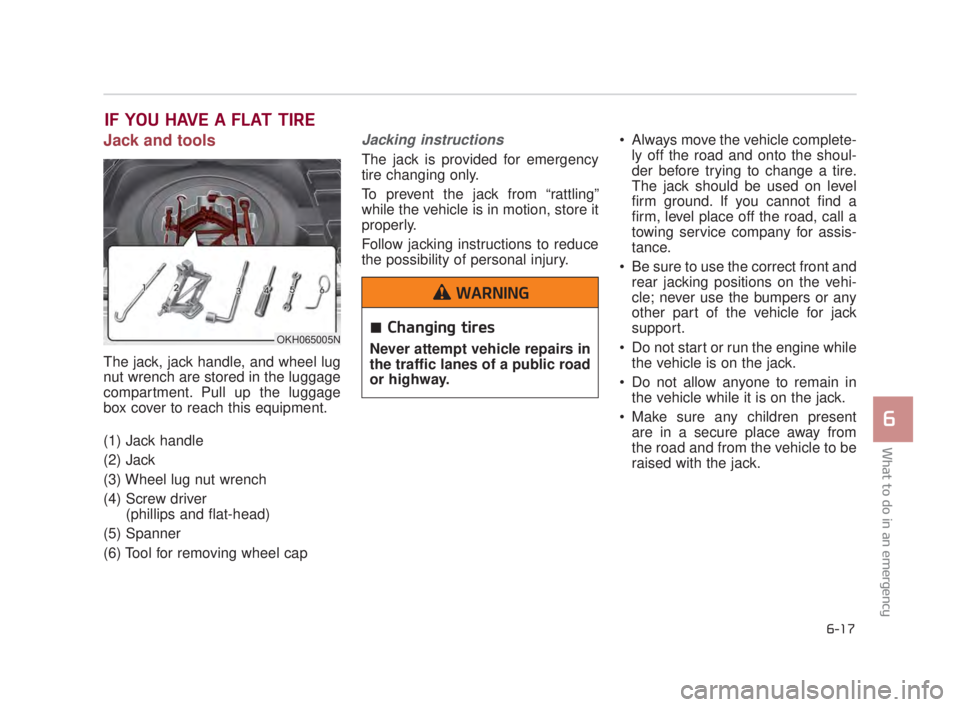
What to do in an emergency
6
6-17
IF YOU HAVE A FLAT TIRE
Jack and tools
The jack, jack handle, and wheel lug
nut wrench are stored in the luggage
compartment. Pull up the luggage
box cover to reach this equipment.
(1) Jack handle
(2) Jack
(3) Wheel lug nut wrench
(4) Screw driver (phillips and flat-head)
(5) Spanner
(6) Tool for removing wheel cap
Jacking instructions
The jack is provided for emergency
tire changing only.
To prevent the jack from “rattling”
while the vehicle is in motion, store it
properly.
Follow jacking instructions to reduce
the possibility of personal injury. Always move the vehicle complete-
ly off the road and onto the shoul-
der before trying to change a tire.
The jack should be used on level
firm ground. If you cannot find a
firm, level place off the road, call a
towing service company for assis-
tance.
Be sure to use the correct front and rear jacking positions on the vehi-
cle; never use the bumpers or any
other part of the vehicle for jack
support.
Do not start or run the engine while the vehicle is on the jack.
Do not allow anyone to remain in the vehicle while it is on the jack.
Make sure any children present are in a secure place away from
the road and from the vehicle to be
raised with the jack.
OKH065005NChanging tires
Never attempt vehicle repairs in
the traffic lanes of a public road
or highway.
WARNING
KH USA 6:2018 4/12/2017 10:21 AM Page 17
Page 393 of 544
Removing and storing the
spare tire
Turn the tire hold-down wing bolt
counterclockwise.
Store the tire in the reverse order of
removal.
To prevent the spare tire and tools
from “rattling” while the vehicle is in
motion, store them properly.
6-18
What to do in an emergency
Tire Jack
Never use the bumper orother parts of the vehicle to
support the vehicle jack. The
vehicle can easily roll off the
jack causing serious injury or
death.
Do not place any portion of your body under a vehicle that
is supported only by a jack.
Use vehicle support stands.
WARNING
Running vehicle on jack
Do not start or run the engine of
the vehicle while the vehicle is
on the jack as this may cause
the vehicle to fall off the jack.
WARNING
OKH063006N
KH USA 6:2018 4/12/2017 10:21 AM Page 18